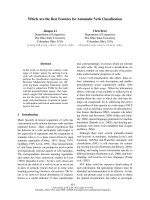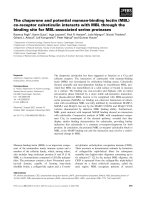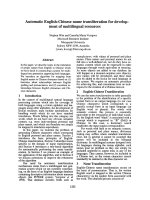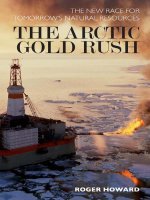The Arctic Gold Rush The New Race for Tomorrow’s Natural Resources pdf
Bạn đang xem bản rút gọn của tài liệu. Xem và tải ngay bản đầy đủ của tài liệu tại đây (1.87 MB, 272 trang )
THE ARCTIC GOLD RUSH
To Claire P.
The Arctic Gold Rush
The New Race for Tomorrow’s
Natural Resources
ROGER HOWARD
Continuum UK Continuum US
The Tower Building 80 Maiden Lane
11 York Road Suite 704
London SE1 7NX New York, NY 10038
www.continuumbooks.com
Copyright © Roger Howard 2009
All rights reserved. No part of this publication may be reproduced or transmitted
in any form or by any means, electronic or mechanical, including photocopying,
recording or any information storage or retrieval system, without prior permission
from the publishers.
First published 2009
British Library Cataloguing-in-Publication Data
A catalogue record for this book is available from the British Library.
ISBN 9781441181107
Typeset by Pindar NZ, Auckland, New Zealand
Printed and bound by MPG Books Group, Bodmin and King’s Lynn
Contents
Maps vii
Acknowledgements xii
Introduction 1
Part 1: The Setting 11
Chapter 1: A Looming Resource War? 13
Chapter 2: The Arctic Thaw 25
Chapter 3: The Great Explorers 35
Part 2: The Issues 43
Chapter 4: Who Owns the Arctic? 45
Chapter 5: Black Gold 62
Chapter 6: The Arctic’s Other Resources 82
Chapter 7: Sea Lanes and Strategy 103
Chapter 8: The Environmental Challenge 120
Part 3: The Contestants 139
Chapter 9: Russia and the Arctic 141
Chapter 10: America’s Arctic Destiny? 164
Chapter 11: The Canadians Look North 182
Chapter 12: Some Other Arctic Claims 200
Conclusion: The Future of the Arctic 218
Notes 227
Bibliography 248
Index 251
Maps vii
Map 1: Coastal state jurisdiction. The Law of the Sea gives coastal states the right to establish clearly defi ned zones extending
from the coast line (baseline) and along the seabed.
Mapsviii
Map 2: Current boundaries of the ‘Arctic Five’. Claims can be extended
beyond the 200-nautical-mile limit if a country can prove that undersea
ridges are part of its continental shelf. The Lomonosov Ridge is thought to
be part of the continental shelf of Russia, Denmark and Canada.
Maps ix
Map 3: The Median Line principle. Every point of a median line is equi-
distant to the nearest point on the shoreline. The UN has given some
indications that it is interested in adopting this principle, which favours
Canada and Denmark.
Mapsx
Map 4: The Sector Method Principle. The Sector Method principle is based
on straight longitude lines. Russia used this principle in its submission to
the UN Commission on the Limits of the Continental Shelf in 2001. This
principle favours the United States and Norway.
Maps xi
Map 5: The Barents Sea disputes. The Loophole is triangular in shape,
bounded on the east by the Russian economic zone, on the south-west by
the Grey Zone claimed by both Russia and Norway, and on the north-west
by the Svalbard fi sheries protection zone.
xii
Acknowledgements
The author is indebted to numerous people for their information
and comments but is particularly grateful to Sir Rodric Braithwaite,
Dr Lawson Brigham, Tim Daffern, Professor Simon Dixon, Mette
Frost, Michael Greenwood, David Jackson, Andrew Latham, Rafi q
Latta, Professor Frederic Lasserre, Dr Rob Mandley, Olav Stokke,
Claire Pinney (not least for her Russian translations), Professor Don
Rothwell and Derek Teevan.
Roger Howard
Oxford, May 2009
1
Introduction
The place where two Russian explorers hoped to make history and
dramatically seize the attention of the outside world was bleak yet
utterly compelling. As far as every distant horizon they could see only
a frozen, barren landscape that seemed to glow brilliantly beneath
the bright sun and the pale blue sky. Nowhere in this icy wasteland
was there any form of life or movement, and the silence and sense of
isolation were total and overpowering (Map 2).
On that chilled morning of 2 August 2007, as they readied them-
selves for the journey that lay ahead, the explorers were far too busy
to pay much attention to their surroundings. Their mission promised
to be diffi cult, demanding and sometimes dangerous, and even getting
this far had not been an easy task. They had arrived after several
days of journeying on board a research vessel, Akademik Fyodorov,
and a nuclear-powered Russian icebreaker, the Rossiya, which had
smashed a hole through the thick ice below. On board were two
miniature submarines, Mir 1 and Mir 2, both of which had been
safely lowered and were now ready to be launched. The task for the
two men was to descend to the ocean fl oor that lay nearly 14,000 feet
beneath them.
This would be no simple feat. In such extreme temperatures, ma-
chinery freezes and vital instruments malfunction, and making their
way back to the surface would be even more diffi cult because of the
moving ice fl oes. If they failed to fi nd the exact spot where they had
started then the submarines would be unable to break the ice above
them and the crew would face a slow, agonizing death as their air
supply slowly ran out.
But the team was ideally qualifi ed to undertake such a hazardous
mission. The Captain of Mir 1, Anatoly Sagalevich, was a 69-year-
old veteran of numerous operations in these tiny vessels. In earlier
years he had personally led diffi cult operations to the ocean’s depths
to inspect the ghostly underwater graves of sunken ships such as the
Introduction2
Bismarck and Titanic. As a departmental head at Moscow’s prestig-
ious Institute of Oceanology, he had built up an intricate knowledge
of both his vessel and the Arctic’s environment, particularly the
geology that lay far beneath them.
In the cockpit of Mir 2 was another distinguished fi gure whose
name was familiar to millions of ordinary Russians. For 68-year-old
Artur Chilingarov was not only a deputy chairman in Russia’s na-
tional Parliament, but also an outstanding polar scientist with a long
and impeccable record of exploration and research. Over 20 years
before he had been proclaimed as a Hero of the Soviet Union – his
country’s highest honour – in recognition of the exceptional talents
he had shown during a number of expeditions to the South Pole and
elsewhere.
Soon the two men were ready to move, and slowly their vessels
sank down into the water beneath. From their cockpits they looked
up and saw the daylight shine through the ice circle above them until
it gradually faded from view and then disappeared altogether. Now,
after so much preparation, they started their long journey to the sea-
bed, carefully mapping their path so they could retrace their steps.
Finally, after nearly 4 hours, sonar devices told them that they
had, at last, reached the seabed. Sagalevich guided a specially built
robotic arm, attached to his vessel’s exterior, to collect samples of
soil and rocks from the dark waters around them. But this was not
the main purpose of the mission. With real skill the veteran explorer
now used the exterior arm to plant a Russian fl ag on the seabed, at a
depth of exactly 13,980 feet, in a ceremonial display that he was keen
to photograph. Forged from titanium to stave off rust, and anchored
by a heavy weight, the fl ag had been specially made for this great
occasion. As Sagalevich wrote proudly in his log shortly afterwards,
‘we set the fl ag of the Russian Federation on the fl oor of the Arctic
Ocean’. The months of preparation had fi nally paid off.
Back at Moscow’s Vnukovo airport, large crowds had gathered,
brandishing enormous bottles of champagne and huge national
fl ags, to welcome home the men and women of the Arctic 2007
expedition and fete them as true Russian heroes. As they stepped
onto the red carpet and a brass band played, both Sagalevich and
Chilingarov prepared to make deeply patriotic statements about
their achievement. ‘Russia is a great polar empire’, Chilingarov
exclaimed, adding that this was a victory for every one of his fellow
nationals: ‘I congratulate all the Russians on reaching the North Pole
of the Earth!’ Other Russians spoke in equally ecstatic terms. ‘This
may sound grandiloquent, but for me this is like placing a fl ag on
Introduction 3
the moon; this is really a massive scientifi c achievement’, as Sergei
Balyasnikov, a spokesman for the Arctic and Antarctic Institute in
Moscow, told one international news agency. ‘It was the fi rst ever
dive of manned vehicles under the Arctic ice. We now know that we
can perform this task.’
But unlike the space race of the post-war years, or earlier trips
to the North and South Pole, this journey had been more than
personal achievement and national prestige. The explorers, and
their supporters and unoffi cial sponsors in the Kremlin, did not just
want to be seen to be keeping pace with, or get one step ahead of,
any international rival. It was, instead, part of a carefully planned
operation to assert Russia’s claim over part of a region that seemed to
belong to no one. This was why President Vladimir Putin had already
described the urgent need for Russia to secure its ‘strategic, economic,
scientifi c and defence interests’ in the Arctic, and why Chilingarov, a
close confi dant of the Russian president, has also declared that ‘the
Arctic is ours and we should manifest our presence’.
The Arctic 2007 expedition was playing an important part in this
great game for the Arctic in two distinct ways. On the one hand,
the explorers had taken some geological samples from the seabed
that they hoped would provide convincing evidence that the region
does, after all, belong to Russia. Under international law, Russia,
like any other coastal state, has exclusive economic rights over any
natural resources found in a zone that extends up to 200 miles from
its shores.
1
But it can claim even more if it demonstrates that the
‘natural prolongation’ of its submerged land mass – its continental
shelf – extends beyond that 200-mile limit. In this situation, it can
stake a claim over any resources found within that wider area, one
that might cover an extra distance of up to 150 miles (Map 1).
2
This
area that lies beyond the 200-mile exclusive economic zone is known
as the ‘outer continental shelf’ (OCS).
The crucial treaty on this issue and on many other aspects of
international law is the United Nations Convention on the Law of
the Sea. First drawn up in December 1982, after years of negotia-
tions involving numerous countries, this extensive agreement seeks
to cover almost every aspect of how the seas are governed and used,
even though its provisions are often opaque and incomplete. Over
the intervening years, this ‘Constitution of the Oceans’, once heralded
by a UN Secretary-General as ‘possibly the most signifi cant legal
instrument of this century’, has been ratifi ed by 158 states, although
the single most important player in global politics, the United States,
had still not signed up by the summer of 2009.
3
Introduction4
The 1982 Convention attaches a great deal of importance to the
question of how far any piece of land stretches out to sea. Usually
a land mass reaches out into the ocean until it drops, often quite
sharply, into the much deeper waters of the continental margin. In
many cases, this happens quite close to the shores of the coastal
state, which is nonetheless still entitled to have a 200-mile exclusive
economic zone. But if there is a sudden, discernible drop beyond the
200-mile border, then the coastal country can claim to have an outer
continental shelf. Of all the countries that have signed up to the
1982 Convention, perhaps as many as 70 might have this extended
shelf, although they need to provide compelling geological evidence
of this.
4
In the Arctic, a great deal of argument revolves around the struc-
ture of a massive underwater formation – a submerged mountain
range – known as the Lomonosov Ridge. The key question is whether
it merges with any country’s continental shelf. If it does, then those
sections of shelf, instead of dropping suddenly when they reach
the continental margin, would stretch far out to sea, reaching well
beyond the limits of their respective state’s 200-mile zone and in all
likelihood well beyond the maximum 350-mile limit.
For some years the Russians have been adamant that their own
continental shelf merges with both the Lomonosov and Mendeleev
Ridges. This would mean that they could claim economic rights over
a much greater area, one that starts at their existing territories in
Franz Josef Land, a remote collection of islands in the far north-east
of the Barents Sea, and reaches right up as far as the North Pole. It is
doubtful that the efforts of Chilingarov and Sagalevich really helped
Russia to prove it – some scientists pointed out that the explorers did
little besides take photographs and gathered no meaningful geological
evidence – but this was at least the ostensible purpose of their trip.
5
Of course Moscow has certainly never claimed that this gives
them sovereignty over more than a very limited share of the Arctic
Ocean.
6
To claim any more than a section of such a vast and diverse
area would plainly be absurd, for it covers more than 5.4 million
square miles and touches the shorelines of four other countries: the
United States, Canada, Norway and Denmark, which has claimed
Greenland as its own sovereign territory for nearly two centuries. Nor
does Russia claim that its continental shelf bestows any special rights
over the wider Arctic region, which incorporates not just the Arctic
Ocean but much more besides: this wider region covers just over
8 million square miles, comprising around 6 per cent of the earth’s
surface, and impinges upon the territory of another three countries:
Introduction 5
Sweden, Finland and Iceland. And it is home to around four million
people, about one-third of whom are indigenous and around half are
Russian nationals.
Instead, the Kremlin is seeking to stake its claim over a slice of
territory that runs north of its existing borders and into the frozen
wasteland that lies above the Arctic. Large parts of this region, the
‘High North’, have always been a true no man’s land, or rather a no
man’s frozen sea, an area of permanent pack ice that no man has
ever bothered to claim as his own, or even shown much interest in,
until very recently.
But the diffi cult issue for the Russians, and for any other country, is
to prove it. Again, the 1982 Convention states that a government has
to plead its case before a specially designated United Nations body,
the Commission on the Limits of the Continental Shelf. Several years
before, in December 2001, Moscow had done just that.
7
Six months
later, however, the Kremlin had found its advances spurned by the
Commission, whose members asked for further data that would
make the Russian case more compelling. It was just such geological
evidence that the two Russian explorers had been tasked with fi nding
on the ocean fl oor.
Other members of the ‘Arctic Five’
*
are trying just as hard to
show that this ridge, and other underground formations, give them
their own maritime rights. The Canadian government argues that the
Lomonosov Ridge is an extension of the North American land mass
and its determination to prove the point became clear in November
2008, when it commissioned two mini submarines that, soon after
their planned launch in 2011, will be sent on a series of long-range
missions north and west of Ellesmere Island to gather the necessary
geological evidence to support the government’s case. Canadian sci-
entists hope to soon fi nd what they want, and were encouraged when
in late 2008 a joint United States-Canadian mapping mission to the
Beaufort Sea produced better than expected results. ‘The quality of the
data is astonishing’, as a Halifax-based scientist told the media. ‘We
haven’t analysed it all, but what we found is that the entire Beaufort
Sea – all the way up to the north – is covered with signifi cant amounts
of sediments, which makes our case look very promising.’
8
Some other countries, including Norway, Denmark, Iceland and
the United States, have also either pitched their respective claims to
an outer continental shelf that reaches beyond the standard 200-mile
limit, or look ready to do so. The Danish government is spending
* The ‘Arctic Five’ are Russia, the United States, Canada, Norway and Denmark.
Introduction6
huge sums of money preparing a comprehensive map that it claims
will demonstrate that the Lomonosov Ridge runs from the top of
Greenland all the way to the North Pole. Oslo is also holding high
hopes that the UN Commission will look favourably on its claim for
ownership of areas in the Norwegian Sea, the Barents Sea and the
Arctic Ocean that cover 100,000 square miles. It submitted its own
case to the UN in November 2006, exactly 10 years after signing up
to the 1982 Convention and just within the deadline that the treaty
demands.
9
But there was also another, more emotive, reason for the Arctic
mission. In a matter of mere hours, dramatic pictures of the Russian
fl ag being lodged onto the Arctic seabed had been broadcast around
the world, suddenly focusing attention on a region that not many
people knew much about. This was exactly what the leaders in the
Kremlin had hoped for: the Arctic 2007 expedition was all about
expressing and symbolizing Russia’s claim to the region, as well
as its resurgent national confi dence, before the watching world. ‘If
a hundred or a thousand years from now someone goes down to
where we were, they will see the Russian fl ag’, as Chilingarov told
one Russian news agency.
Of course planting a fl ag in any part of the world doesn’t give any
country a right to rule it. As a spokesman in the US State Department,
Tom Casey, pointed out, ‘I’m not sure whether they put a metal fl ag,
a rubber fl ag or a bedsheet on the ocean fl oor. Either way, it doesn’t
have any legal standing’. Any such ‘rights’ depend on international
law, and although many countries openly fl out it, most are reluctant
to overtly do so for fear of sanctions, military confl ict or, in some
cases, frightening off foreign investors. No one is quite sure who owns
large parts of the Arctic, but it was certain that the fl ag ceremony
did not bestow any special right on Moscow. It did, however, seem
to be symbolic of some people’s worst fears about the Russians: that
they would hold few scruples about seizing much of the Arctic for
themselves.
This was why the footage provoked a powerful international
reaction, particularly from those who were closest to hand. To the
Canadians it seemed threatening, reminiscent of a bygone imperial
age when great powers simply seized land by force and then planted
a fl ag to claim it as their own. Foreign Minister, Peter Mackay,
vigorously protested that ‘this isn’t the fi fteenth century. You can’t go
around the world and plant fl ags’, while the European Union’s Energy
Commissioner, Andris Piebalgs, later stated simply that he was ‘not
at ease with developments in the Arctic’ and that ‘countries that are
Introduction 7
bordering the Arctic should be extremely serious about not making
confl ictual announcements, because whatever solution is found, it
should be between all the countries bordering it’.
10
Newspapers across
the world echoed the same message, condemning Moscow’s ‘stunt’ as
a sign of its ‘Czarist impulses’ and claiming that it was just a ‘Kremlin-
sponsored act of bravado aimed at boosting national pride’.
Back in Moscow, there was little sign of remorse as international
tension suddenly heightened. ‘We are happy that we placed a Russian
fl ag on the ocean bed, where not a single person has ever been, and
I don’t give a damn what some foreign individuals think about that’,
claimed Artur Chilingarov. Making a reference to an expedition led
by a Soviet Arctic researcher, Ivan Papanin, on a drifting ice fl oe in
the winter of 1937, he claimed that ‘Russia [has] always expanded its
territory by northern lands’ and that ‘seventy years ago, they would
say, “Bolsheviks have conquered the Arctic”. Now our crew is United
Russia. The Russian fl ag is the point of the North Pole of the Earth.
Full stop. If someone doesn’t like it, let them dive as deep as 14,000
feet and try and leave something down there’. A short distance away
from where he was speaking, some youths from the pro-Kremlin
Young Guard movement were showing even less remorse. ‘Who has
shown the planet what is what?’ they chanted, ‘it’s our Arctic explorer
Chilingarov! The Russian people are in the Arctic now!’
Superfi cially, it is of course surprising that the Arctic should arouse
so much attention and interest. Yet, as other parts of the world prove,
most obviously the Middle East, some of the world’s harshest and
most diffi cult environments can also harbour great natural wealth.
The heart of the issue is climate change. Although local tempera-
tures have always ebbed and fl owed, the climatic variations in the
region over the past quarter century are far more dramatic than
anything it is known to have previously witnessed. Over the past
six decades average winter temperatures in western Canada and
Alaska have increased by as much as seven degrees Fahrenheit, and
as temperatures rise, so too does the speed with which the Arctic ice
is melting.
Of course, the Arctic Ocean has never been completely frozen over,
because the constant movement (the fracturing and melting of its vast
ice packs) often creates open waters. Even then, there are consider-
able seasonal fl uctuations. In September and October, after months
of summer sun, the ice packs are confi ned mostly to the ocean’s
northern-most regions, and only a small amount fl oats into some of
the constituent waters, such as the Greenland, Kara and Barents Seas
and the Canadian archipelago, that lie further south. In February and
Introduction8
March, however, a great deal of ice is usually found in all of these
areas, as well as in peripheral waters, such as the Bering Sea, Hudson
Bay, the Sea of Okhotsk and Baffi n Bay (Map 2).
What has happened in recent years is a drastic alteration of this
pattern. Around 41 per cent of permanent ice is estimated to have
already completely disappeared from the region over the last quarter
century, and every year a further million square miles or so vanishes,
shrinking the ice cap to around half of the size it covered in the mid-
twentieth century. Data provided by NASA satellites shows that in
1979, perennial sea ice covered an area twice the size of the United
States. Twenty-fi ve years later, however, an area equivalent to New
York, Georgia and Texas had completely vanished, mostly from the
Beaufort, Chukchi, Siberian and Laptev Seas.
The implications of this rapid and drastic climate change are, of
course, vast, affecting everyone in the region and many more beyond,
in some way or another. This is the subject of numerous specialist stud-
ies, most notably a huge research document, the Arctic Climate Impact
Assessment, published in 2004. This extensive study has argued that
a great many people will inevitably lose out from these changes: ‘the
reduction in sea ice is very likely to have devastating consequences
for polar bears, ice-dependent seals, and local people for whom the
animals are a primary food source’. But it adds there could also be
some benefi ts too, including the opening of job opportunities for local
people and, from an environmental point of view, ‘increased areas of
tree growth in the Arctic [that] could serve to take up carbon dioxide
and supply more wood products and related employment’.
11
For many governments – not just those whose own territory
extends beyond the Arctic Circle – what matters most, at least for
the moment, are the region’s natural resources and their accessibility
to them. Above all, many experts have long been convinced that the
Arctic Ocean has resources on a vast scale and recognized that the
gradual thaw of its ice is now making them accessible for the fi rst
time. A leading American organization, for example, estimates that
the region might even hold as much as 13 per cent of the world’s
remaining deposits of oil and 30 per cent of its gas, while traces of
numerous precious metals, including gold, platinum and iron ore,
have also been found.
12
Such revelations have become even more important because by
the time that Chilignarov and Sagalevich made their underwater
expedition, fears were mounting that the world’s natural resources
– its supply of oil in particular – were beginning to run out. The
market price of crude oil started to climb considerably in early
Introduction 9
2004, allowing producers to reap vast earnings. It was a tempting
reminder that whoever could claim the Arctic’s resources would have
an increasingly precious commodity on their hands.
The likely presence of so many natural resources is a vastly more
important consideration than any prospect of international shipping
routes that might one day traverse the Arctic’s waters. In recent years,
there have been media reports of two such sea lanes. One of these
runs through the Northwest Passage, a series of distinct but connected
straits that stretch along the Canadian and Alaskan shores and link
the Pacifi c and Atlantic Oceans. The other is Russia’s Northern
Sea Route, which runs along across the Barents, Kara, Laptev, East
Siberian and Chukchi Seas, through the Bering Straits and then into
the northern Pacifi c (Map 2). Both, it is sometimes said, would cre-
ate a shorter link between east and west than the Suez and Panama
Canals currently offer, and the opening of these new commercial
‘highways’ would drastically reduce sailing times and slash shipping
costs. But many of these reports have been exaggerated; although
these trade routes will certainly become more navigable during the
summer months, they are most unlikely to become ice-free all year
round. As a result, sailing times will remain uncertain and tight
schedules could be easily disrupted.
However, in the context of oil, gas and other natural resources
the full importance of the outer continental shelf, in the Arctic in
particular but also throughout the wider world, becomes clear. A very
high proportion of the world’s oil and natural gas is estimated to lie
offshore and now that the technology to develop these reserves has
been developed, coastal states the world over have a greater interest
than ever before in demonstrating that they have an outer continental
shelf. The economic future of some of the world’s developing coun-
tries, such as Barbados, Tonga and Palau, could even hinge on this
single issue.
No one is quite sure, however, who rules large parts of this region,
which has only recently assumed so much importance. There are all
sorts of competing claims here, all of which have long been ignored
or downplayed, but which are now the focus of intense scrutiny from
governments, lawyers, explorers, geologists and military men.
Of course, the same could be said about other regions whose fate
has nonetheless been resolved amicably. Disputes over the Antarctic
were temporarily settled in 1959 when representatives of 12 coun-
tries, including the two superpowers as well as important players
on the international stage, such as France, Japan and the United
Kingdom, met in Washington to negotiate and sign an agreement
Introduction10
to determine the region’s future. Under the terms of the deal, each
signatory state agreed not to ‘recognize, dispute or establish territo-
rial sovereignty claims’ to the region for the next 50 years.
13
This
was because ‘Antarctica shall continue forever to be used exclusively
for peaceful purposes and shall not become the scene or object of
international discord’. As a result, the signatories decided that ‘any
measure of a military nature, such as the establishment of military
bases and fortifi cations, the carrying out of military manoeuvres, as
well as the testing of any type of weapon’ should be prohibited.
14
Since it came into effect in June 1961, a further 38 countries have
signed and ratifi ed its provisions.
Unfortunately this is not a helpful analogy. This is not because
of the geographical differences between them – many of the Arctic’s
disputed regions are seas, whereas Antarctica is a land mass – but
for another reason. The 1959 treaty has proved enduring essentially
because oil and natural gas were discovered in Antarctica only long
after it was signed. Since the nineteenth century it had been regarded
as a lucrative source of whale and seal stocks, but petroleum was
found only in the early 1980s. Now that the technology to exploit
these resources has been developed, it is possible that the agreement
might break down. In any event, the southern region does not have
the Arctic’s superb strategic setting.
It is tempting to view the Arctic as the likely setting of a scenario
that has become much discussed in recent years and continues to be
much feared: the scenario of brutal, bitter and bloody confrontation
waged between rival international powers that are desperate to ac-
quire the world’s diminishing supply of natural resources. From this
viewpoint the provocative journey of Chilingarov and Sagalevich
appears, if not quite an opening round, a premonition of the trouble
that lies ahead. However, the central argument of this book is that this
scenario is even less likely to happen in the Arctic than elsewhere, but
there are other dangers that soon could become very real.
Part 1
The Setting
This page intentionally left blank









